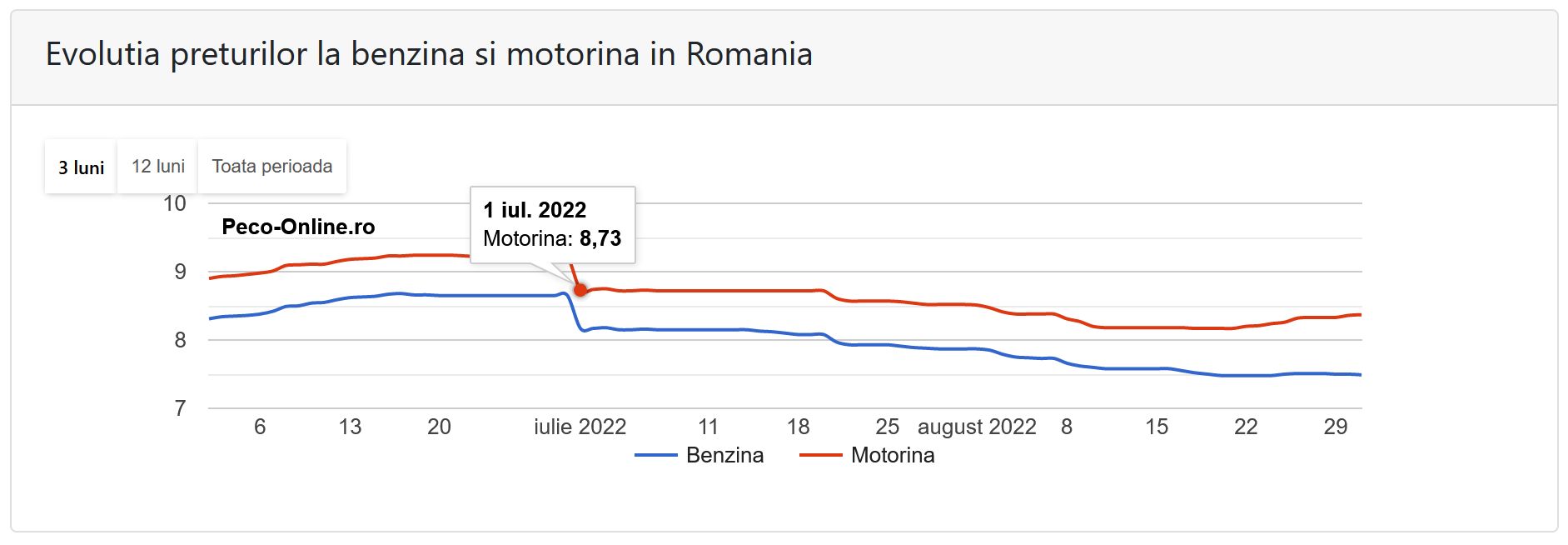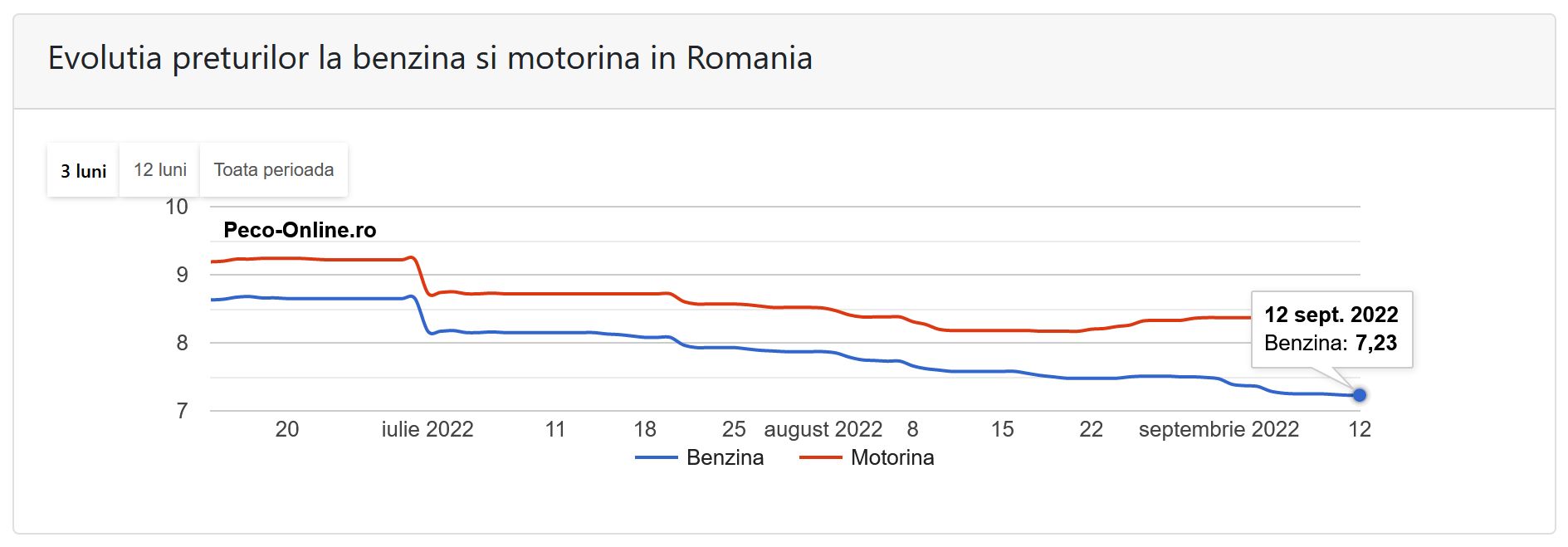
We have entered the final 18 days in which petrol stations can still voluntarily apply the 50p discount on fuel and diesel prices continue to rise compared to petrol prices, reaching an average of 30p below the level on July 1, when the compensation scheme took effect validity The danger is that the price of diesel will return to the mark of more than 9 lei/liter. Why these increases?
Diesel fuel prices are constantly rising compared to gasoline
The average price of a liter of diesel fuel continued to grow and reached the level 8.41 lei September 12, 2022, according to Peco-online.ro.

For comparison, on the date of 1st of July when it came into effect compensation scheme with 50 moneythe average price of a liter of diesel fuel was 8.73 lei.

The current price of diesel fuel has also increased compared to August 31, 2022, when it was 8.37 lei.
On the other handthe average price of a liter of gasoline is constantly decreasing from July 1, 2022when he reached the threshold 8.17 lei.

On the date September 12the average price of a liter of gasoline was 7.23 lei.

The price of gasoline is also down compared to the end of August this year, when it was 7.49 lei.
Why are diesel prices rising and petrol prices falling?
We produce more gasoline than we consume. The opposite is true with diesel, and we are dependent on imports
The explanation for the higher prices of diesel fuel compared to gasoline was given by the Minister of Energy Virgil Popescu right at the government meeting on June 30, at which a decision was made on a voluntary compensation scheme of 50 pesos for gasoline and diesel. According to him, in the conditions of the war in Ukraine, the high demand for oil products in Ukraine led to an increase in prices.
- “(..) Romania consumes 6.2 million tons of diesel and 1.7 million tons of gasoline (N/A annual consumption). We produce more gasoline than we consume, but we produce less diesel, about half. We depend on diesel imports. And it’s not that we don’t produce, that we can’t produce, it’s technical capabilities. A barrel of oil yields more gasoline, less diesel, and less /….
- And then we have to import, and the import is done at the regional quotation. Those selling in Ukraine, Romania, Greece and Bulgaria, all countries in the region, also bid on this regional quote. This, so to speak, is our problem.
- The price of diesel has increased much more than the price of a barrel of oil. To give you an idea, if it was around $700 a ton in January, it’s now $1,300 or so. So it has grown significantly over this period since the start of the war, mostly since February 25th.
- From there, the price went up, and then, if you don’t import, you have a deficit, if you import, you have this price,” the Minister of Energy said on June 30.
About 63% of diesel fuel imports belong to Russia or pass through it in transit
More about how the Romanian oil market was affected by sanctions against Russia, the Ministry of Energy recently reported in a response to interpellation Deputy AUR Dan Tanase. (VIEW THE DOCUMENT HERE)
- “The average annual consumption of transportation fuel (gasoline, diesel, aviation fuel) in Romania is at the level of approx. 7.3 million tons/year, of which the largest share is accounted for by the consumption of diesel fuel with an average annual value of approx. 5.9 million tons/year (gasoline – approx. 1.3 million tons/year).
- The annual import of crude oil and oil products (especially diesel fuel) from the Russian Federation, as well as those transiting through the Russian Federation (we are talking about the import of crude oil and oil products produced by Rompetrol, from Kazakhstan) is significant for Romania. of the market, which is on average approx. 63% of the total import of diesel fuel and an average of approx. 80% of crude oil imports”. it is stated in the answers sent by the Ministry of Energy.
Romania is one of the EU countries that has been significantly affected by the sanctions imposed on Russia
The Ministry shows that the oil market is a liberalized market, crude oil is a commodity listed on the stock exchange, in a global market operating on the basis of the principles of free competition.
There is a competitive climate in the market of oil products – fuel prices are set freely, based on the ratio of supply and demand in the domestic market, respectively, in the foreign market.
Romanian refineries, which purchase domestic crude oil production (about 1/3 of domestic consumption) and import about two-thirds, currently have an operating capacity of approx. 12 million tons/year.
- “At the moment, the fuel market in Romania is stable and functional, in terms of supply and access to goods. Of course, the price problem is obvious, its reasons are many, given the extremely complex regional and global context.
- And Romania is one of the Member States whose oil markets have been significantly affected by the sanctions imposed on the import of crude oil and petroleum products from the Russian Federation, but we believe that the difficulties that have arisen can be overcome, obviously, assuming that some restrictions on consumption and certain implications for final fuel prices that will affect final consumers in Romania.
- Considering this situation, the economic operators of the oil industry in Romania have started measures to identify alternative sources of supply on the world market and conclude contracts to ensure the consumption needs of the domestic market,” the quoted document says.
What oil refining capacity does Romania have?
According to official data, Romania has an oil refining capacity of about 12.5 million tons, of which:
- Petrobrazi Refinery (OMV Petrom) – 4.5 million tons/year;
- Petromidia Refinery (Rompetrol) – 5.2 million tons/year;
- Refinery “Petrotel” (Lukoil) – 2.5 million tons/year;
- Vega Refinery (Rompetrol) – 0.350 million tons/year.
The oil market in Romania will become even more difficult in the near future under the conditions that the EU adopted at the end of May this year. embargo on Russian oil covering more than “two-thirds” of EU imports from Russia.
Import of natural gas: with whom Romania has relationships
As for natural gas reserves, the Ministry notes that it has adopted certain action plans, which provide for measures to eliminate or mitigate the consequences of a possible failure in the supply of natural gas.
“The import of natural gas in Romania is carried out by commercial companies (suppliers). In Romania, in accordance with the provisions of the Energy and Natural Gas Law no. 123/2012 as amended, natural gas suppliers are obliged to ensure continuity of natural gas supply to consumers, given that it is a public service.
At the moment, Romania has connections with the following countries:
- Hungary;
- Bulgaria;
- Republic of Moldova;
- Ukraine.
At the moment, gas imports are taking place in regular mode (about 5 million m3/day),” the Ministry of Energy said in a reply sent last month.
The Ministry also notes that at the EU level in June of this year, a Regulation was adopted, which provides that reserves must be created in underground gas storage facilities on the territory of the member states at least until the beginning of the winter of 2022-2023. 80% capacity and 90% capacity before the beginning of the following winter periods.
At the aggregate level, the Union will strive to jointly create 85% of total underground gas storage capacity in 2022.
As of June 28, 2022, natural gas reserves in warehouses amounted to 1,290.4 million cubic meters, which is 42.03% of the total capacity (as of the corresponding date in 2021, reserves amounted to 1,036.9 million cubic meters, or 33.7%).
In accordance with the provisions of the Regulation, Romania’s intermediate storage targets are 46% – by August 1, 57% – by September 1, 66% – by October 1. Taking into account already existing reserves and a daily storage rate of approximately 10-12 million cubic meters per day. we believe that Romania will have no problems with fulfilling its obligations.” this is also shown in the document.
What the Ministry of Energy does not say: Romania needs to import natural gas
The Ministry of Energy is silent that if during periods of maximum demand (January-March) gas sources from domestic production and from natural gas storages will be used to the maximum, and the volumes of gas purchased on exchanges will be short-term. standardized production does not cover the gas requirement to support the national transport system (SNT) within operational constraints, then the only available source is import.
These clarifications were recently made by Transgaz itself during the auction, at which it wants to mainly purchase imported natural gas, the contract is valued at more than 1.03 billion lei.
How much is a liter of gasoline and diesel today in Bucharest
Data from the Price Monitor program run by the Competition Council, where fuel prices are displayed without the 0.5 lei/l discount (which is, however, applied at checkout), show that today, September 13, Bucharest has the lowest price for standard gasoline costs 7.63 lei at the Petrom station (Doctora Herescu St.), respectively. Applying a 50 money discount results in a price of 7.13 lei.
At the same station, the price of a standard Petrom diesel today is 8.89 lei, which means 8.39 lei with a discount of 50 money.
The information is also confirmed in the Peco-online.ro application, where all prices are displayed with a discount of 50 money.
Data analyzed by HotNews.ro shows that the 5 main gas station chains, Petrom, Lukoil, OMV, MOL, Rompetrol, on Thursday, September 1, 2022, had the following prices:
Standard gasoline:
- Petrom: from 7.13 to 7.20 lei
- Lukoil: from 7.16 to 7.21 lei
- Mole: from 7.24 to 7.30 lei
- OMV: from 7.25 to 7.28 lei
- Rompetrol: from 7.24 to 7.28 lei
Standard diesel:
- Petrom: from 8.39 to 8.42 lei
- Lukoil: from 8.36 to 8.39 lei
- Mol: from 8.46 to 8.52 lei
- OMV: from 8.47 to 8.50 lei
- Rompetrol: from 8.42 to 8.46 lei
It remains to be seen in the next period what the Government will decide at the end of September, namely whether it will maintain this aid scheme or not.
- SEE THE DECREE ON 50 MONEY COMPENSATIONS HERE
Source: Hot News RO
Anna White is a journalist at 247 News Reel, where she writes on world news and current events. She is known for her insightful analysis and compelling storytelling. Anna’s articles have been widely read and shared, earning her a reputation as a talented and respected journalist. She delivers in-depth and accurate understanding of the world’s most pressing issues.